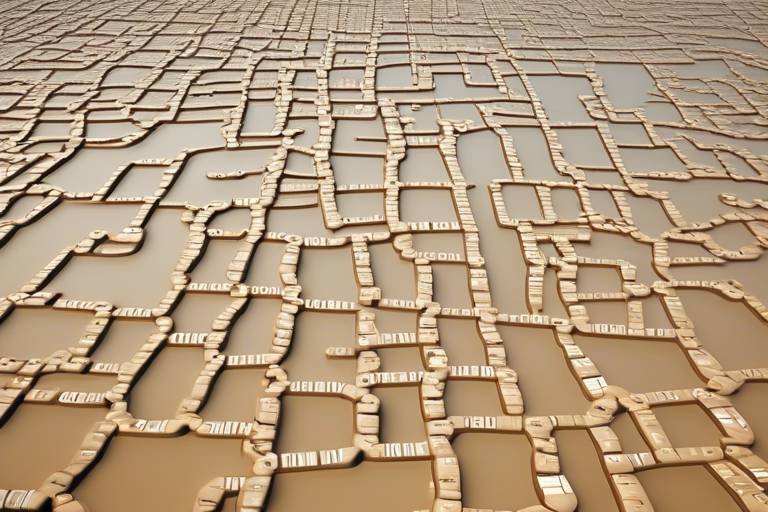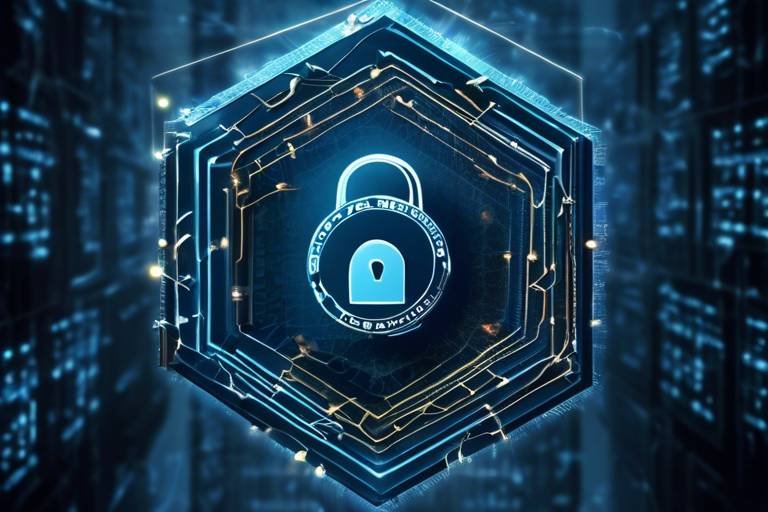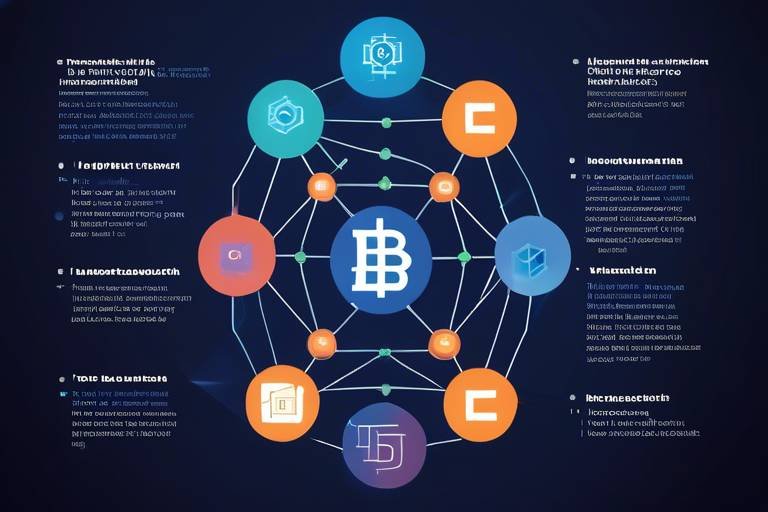How Blockchain Can Facilitate Efficient Water Management
Water is one of our most precious resources, yet managing it efficiently has become a daunting challenge. With the increasing demand for clean water and the pressures of climate change, traditional water management systems often fall short, leading to inefficiencies and waste. Enter blockchain technology—a revolutionary tool that promises to change the game in water management. Imagine a world where every drop of water is tracked, every transaction is transparent, and every stakeholder has access to real-time data. Sounds like a dream, right? Well, with blockchain, this dream is becoming a reality.
At its core, blockchain is a decentralized digital ledger that records transactions across many computers. This means that once a record is added, it cannot be altered, ensuring the integrity and transparency of data. So, how can this technology be applied to water management? The potential is enormous. It can enhance accountability, reduce wastage, and streamline processes—all while promoting sustainable practices. In this article, we’ll dive into how blockchain can facilitate efficient water management, tackling current challenges and exploring its myriad benefits.
Before we delve deeper, let's take a moment to understand what blockchain is all about. At its essence, blockchain is a series of blocks (hence the name) that store data in a way that is both secure and transparent. Each block contains a list of transactions, a timestamp, and a unique cryptographic hash that links it to the previous block, creating a chain. This structure is what makes blockchain so powerful—it allows for decentralized control, meaning no single entity has authority over the entire network.
Now, why is this important for water management? The answer lies in the principles of transparency and accountability. With blockchain, all stakeholders, from government agencies to consumers, can access information about water usage, distribution, and quality in real-time. Imagine being able to track the source of your water, understand its journey, and verify its quality—all at your fingertips! This level of transparency can help build trust among stakeholders and encourage responsible water usage.
Despite the critical importance of water, many regions face significant challenges in managing this vital resource. Some of the most pressing issues include:
- Inefficiencies: Traditional systems often rely on outdated infrastructure and manual processes, leading to delays and errors.
- Lack of Transparency: Stakeholders often operate in silos, resulting in a lack of visibility into water distribution and usage.
- Resource Wastage: Without accurate data, it's challenging to identify and address leaks or overconsumption.
These challenges highlight the urgent need for innovative solutions, and blockchain stands out as a promising candidate to address these issues head-on.
Implementing blockchain technology in water management can bring numerous benefits, including:
- Improved Data Accuracy: With a decentralized ledger, the risk of data tampering is significantly reduced, ensuring that all information is accurate and trustworthy.
- Enhanced Traceability: Blockchain allows for the tracking of water from its source to the end-user, providing insights into usage patterns and potential wastage.
- Increased Stakeholder Trust: When all parties have access to the same data, it fosters collaboration and trust among stakeholders.
The decentralized nature of blockchain is one of its most significant advantages. By distributing data across multiple nodes, it eliminates the need for a central authority, making it nearly impossible for any single entity to manipulate the data. This decentralization fosters transparency, allowing stakeholders to monitor resource usage effectively. Imagine a farmer being able to see how much water is being used in their region in real-time, or a government agency tracking water quality across multiple sources. This level of transparency is a game-changer.
Another exciting application of blockchain in water management is the use of smart contracts. These are self-executing contracts with the terms of the agreement directly written into code. In the context of water distribution, smart contracts can automate agreements, ensuring fair usage and timely payments. For instance, a smart contract could automatically release water to a farmer based on predefined conditions, such as soil moisture levels, reducing administrative overhead and speeding up the process.
Across the globe, several initiatives have already begun to harness the power of blockchain in water management. For example, in Singapore, the government has implemented blockchain solutions to monitor water quality and distribution in real-time, significantly improving response times to potential contamination issues. Similarly, in Australia, blockchain technology is being used to track water rights and allocations, ensuring fair distribution among stakeholders. These case studies demonstrate the tangible benefits of adopting blockchain in water management systems.
While the benefits of blockchain in water management are clear, there are also regulatory and policy considerations to address. Governments and regulatory bodies must create supportive policies that facilitate the adoption of blockchain technology. This includes establishing clear guidelines on data privacy, security, and interoperability. Without a conducive regulatory environment, the potential of blockchain may remain untapped.
Looking ahead, the role of blockchain in water management is poised to grow. As we face the realities of climate change, blockchain can help enhance resilience by providing accurate data for better decision-making. Additionally, as more stakeholders recognize the importance of sustainable practices, blockchain can promote accountability and drive the shift towards more responsible water usage.
In conclusion, blockchain technology holds incredible potential to revolutionize water management. By enhancing transparency, improving data accuracy, and fostering trust among stakeholders, blockchain can pave the way for a more sustainable and efficient water future. It’s time for governments, organizations, and individuals to consider how they can leverage this technology to address the pressing challenges of water management. Let’s embrace the change and work together for a better tomorrow!
Q: What is blockchain technology?
A: Blockchain is a decentralized digital ledger that securely records transactions across multiple computers, ensuring data integrity and transparency.
Q: How can blockchain improve water management?
A: Blockchain enhances water management by providing accurate data, improving traceability, and fostering trust among stakeholders.
Q: What are smart contracts?
A: Smart contracts are self-executing agreements with the terms written into code, allowing for automated processes in water distribution.
Q: Are there any real-world examples of blockchain in water management?
A: Yes, countries like Singapore and Australia have implemented blockchain solutions to improve water quality monitoring and distribution.

Introduction to Blockchain Technology
Blockchain technology is often hailed as a revolutionary advancement, akin to the invention of the internet. At its core, blockchain is a decentralized digital ledger that records transactions across many computers in such a way that the registered transactions cannot be altered retroactively. This ensures a level of security and transparency that is hard to achieve with traditional systems. Imagine a public library where every book borrowed is logged by multiple librarians simultaneously; if one librarian tries to change the record, the others would quickly notice and correct it. This is how blockchain operates, providing a robust framework for various applications, including water management.
The fundamental principles of blockchain revolve around three key components: decentralization, transparency, and security. Each transaction is grouped into a block, and once filled, that block is added to a chain of previous blocks, forming a chronological and immutable record. This structure not only promotes accountability but also enhances trust among stakeholders, as everyone has access to the same information in real-time.
When applied to water management, blockchain can address many inefficiencies that plague the sector. Traditional water management systems often suffer from a lack of transparency, making it difficult for stakeholders—ranging from government agencies to consumers—to track water usage and distribution accurately. By leveraging blockchain, we can create a system where all transactions related to water usage are recorded transparently and can be audited easily. This not only fosters trust but also encourages responsible water consumption practices.
Additionally, the use of smart contracts—self-executing contracts with the terms of the agreement directly written into code—can automate many processes within water management. For instance, these contracts can ensure that water is distributed fairly based on usage patterns, and payments are made automatically when certain conditions are met. This reduces the administrative burden on agencies and ensures that resources are allocated efficiently.
In summary, blockchain technology offers a promising avenue for improving water management systems. By enhancing transparency, accountability, and efficiency, it can help us tackle the pressing challenges of water scarcity and mismanagement. As we delve deeper into the potential of blockchain in this sector, it becomes increasingly clear that the time for innovation is now.

Current Challenges in Water Management
Water management is a crucial aspect of ensuring sustainability and efficiency in our increasingly resource-constrained world. However, this sector faces a myriad of challenges that hinder its effectiveness. One of the most pressing issues is the inefficiency in water distribution systems. Aging infrastructure and outdated technologies often lead to significant water loss through leaks and inefficiencies, with estimates suggesting that up to 30% of water is wasted before it even reaches consumers. This not only strains our water resources but also increases operational costs for utilities.
Moreover, there is a glaring lack of transparency in water management processes. Stakeholders, including consumers, regulators, and environmental organizations, often struggle to obtain accurate and timely information about water usage and availability. This opacity can lead to mismanagement and a general mistrust among users. Imagine trying to navigate a maze without a map; that’s what it feels like for many stakeholders trying to make informed decisions about water usage.
Another significant challenge is the growing demand for water due to population growth, urbanization, and climate change. As more people flock to cities and the climate becomes increasingly unpredictable, the pressure on existing water resources intensifies. This situation is exacerbated by resource wastage in agricultural practices, where inefficient irrigation methods lead to excessive water consumption. According to the Food and Agriculture Organization (FAO), agriculture accounts for about 70% of global freshwater withdrawals, highlighting the urgent need for innovative solutions to optimize water use.
In addition to these challenges, regulatory hurdles pose a significant barrier to effective water management. Many regions lack comprehensive policies that promote sustainable practices or the adoption of new technologies. As a result, water utilities may be slow to implement modern solutions that could enhance efficiency and transparency. Without supportive frameworks, the potential for innovation remains largely untapped.
Finally, the issue of data fragmentation cannot be overlooked. Water data is often siloed across different agencies and organizations, making it difficult to obtain a holistic view of water resources. This fragmentation can lead to poor decision-making and ineffective resource allocation. If water management were a symphony, the current state would resemble a cacophony, with each instrument playing its own tune rather than harmonizing to create a cohesive sound.
In summary, the current challenges in water management—inefficiencies, lack of transparency, growing demand, regulatory hurdles, and data fragmentation—underscore the urgent need for innovative solutions. As we delve deeper into the potential of blockchain technology in addressing these issues, it becomes clear that a transformative approach is not just desirable but necessary for a sustainable water future.
- What are the main challenges in water management today? The main challenges include inefficiencies in distribution, lack of transparency, growing demand, regulatory hurdles, and data fragmentation.
- How does blockchain address these challenges? Blockchain enhances transparency, improves data accuracy, and enables smart contracts, which can automate processes and ensure fair usage.
- Why is transparency important in water management? Transparency fosters trust among stakeholders and enables informed decision-making regarding resource usage and sustainability practices.
- What role can smart contracts play in water distribution? Smart contracts can automate agreements, ensuring timely payments and fair usage, while reducing administrative overhead.

Benefits of Blockchain in Water Management
When we think about water management, it’s easy to overlook the complexities involved in ensuring that this precious resource is used efficiently and sustainably. Enter blockchain technology—a game changer that can address many of the challenges we face today. By leveraging the unique properties of blockchain, we can unlock a plethora of benefits that can transform how water is managed, distributed, and monitored.
One of the primary advantages of blockchain is its ability to enhance data accuracy. Traditionally, water management systems have relied on various stakeholders to report usage and distribution metrics, often leading to discrepancies and misinformation. With blockchain, data is recorded in a decentralized ledger that is immutable and transparent. This means that once data is entered, it cannot be altered or deleted, ensuring that all stakeholders have access to the same reliable information. Imagine a world where every drop of water used is accurately accounted for—this is the potential that blockchain brings to the table.
Moreover, the traceability offered by blockchain is invaluable. Each transaction, whether it’s the allocation of water resources or the payment for water services, is documented in real-time. This creates a clear trail that can be followed, promoting accountability among users and providers alike. For instance, if a water supplier claims to provide a certain quantity of water, stakeholders can verify this claim against the blockchain records, ensuring that everyone is held accountable for their actions. This level of transparency not only builds trust but also fosters collaborative efforts to manage water resources effectively.
Speaking of trust, blockchain enhances stakeholder confidence in water management systems. When people know that their contributions and usage are being tracked transparently, they are more likely to engage positively with the system. This could lead to increased participation in conservation efforts and compliance with regulations. For example, if consumers can see their water usage patterns and understand how their actions impact the community, they may be more inclined to adopt sustainable practices.
Another exciting aspect of blockchain in water management is the use of smart contracts. These self-executing contracts with the terms of the agreement directly written into code can automate various processes in water distribution. Imagine a scenario where water usage is automatically monitored, and payments are made instantly based on real-time data. This not only reduces administrative overhead but also ensures that all parties are treated fairly. With smart contracts, disputes over water usage can be minimized, leading to a smoother operation overall.
To illustrate the benefits of blockchain in water management, let’s consider a few key points:
- Improved Efficiency: Streamlining processes reduces delays and enhances service delivery.
- Cost Savings: By minimizing administrative tasks and errors, organizations can save money that can be redirected towards sustainability efforts.
- Enhanced Collaboration: With all data accessible to stakeholders, collaborative decision-making is facilitated, leading to better resource management.
In conclusion, the benefits of implementing blockchain technology in water management are vast and varied. From improving data accuracy and traceability to fostering trust and automating processes, blockchain has the potential to revolutionize how we manage our most vital resource. As we continue to face challenges related to water scarcity and distribution, embracing innovative solutions like blockchain could be the key to a sustainable and efficient water future.
Q: How does blockchain ensure data accuracy in water management?
A: Blockchain records data in a decentralized and immutable ledger, ensuring that once information is entered, it cannot be altered or deleted. This creates a reliable source of truth for all stakeholders.
Q: What are smart contracts, and how do they work in water distribution?
A: Smart contracts are self-executing contracts with the terms of the agreement written into code. They can automate processes such as monitoring water usage and processing payments based on real-time data.
Q: Can blockchain help in promoting sustainable water practices?
A: Yes! By providing transparency and traceability, blockchain encourages stakeholders to adopt sustainable practices and fosters a culture of accountability.

Decentralization and Transparency
The concept of decentralization is at the very heart of blockchain technology, and it brings a revolutionary change to water management systems. Imagine a world where every drop of water is accounted for, where stakeholders can access real-time data without the need for a central authority. This is not just a dream but a tangible reality that blockchain can help create. By distributing data across a network of computers, blockchain eliminates the risks associated with centralized databases, such as data manipulation and unauthorized access. In the context of water management, this means that all parties—be it government agencies, water suppliers, or consumers—can view and verify information independently.
Transparency is another critical advantage offered by blockchain. In traditional water management systems, data is often siloed, leading to inefficiencies and mistrust among stakeholders. With blockchain, every transaction is recorded in a secure, immutable ledger that is accessible to all authorized users. This level of transparency not only fosters trust but also encourages accountability. For instance, if a water utility company claims to have reduced water loss by 20%, stakeholders can independently verify this claim through the blockchain records. This real-time visibility into water usage and distribution can significantly reduce waste and promote responsible consumption.
Moreover, the decentralized nature of blockchain allows for enhanced collaboration among various stakeholders. Imagine a scenario where farmers, municipalities, and environmental organizations can share data seamlessly. This interconnectedness enables better decision-making and resource allocation. For example, farmers can receive real-time updates on water availability, helping them optimize irrigation schedules and reduce water waste. Similarly, municipalities can monitor consumption patterns, identifying areas where conservation efforts are needed most.
In summary, decentralization and transparency are not just buzzwords; they are essential components that can drive efficiency in water management. By adopting blockchain technology, we can create a more accountable and transparent system that benefits everyone involved. The implications of such a shift are profound, paving the way for a future where water resources are managed sustainably and equitably.
- What is blockchain technology? Blockchain is a decentralized digital ledger that records transactions across a network of computers, ensuring data integrity and security.
- How does blockchain improve transparency in water management? By providing a secure and immutable record of transactions that all stakeholders can access, blockchain enhances accountability and trust.
- Can blockchain reduce water waste? Yes, by facilitating real-time data sharing and monitoring, blockchain can help identify areas of inefficiency and promote responsible water usage.
- What are smart contracts? Smart contracts are self-executing contracts with the terms of the agreement directly written into code, allowing for automated and efficient transactions.

Smart Contracts in Water Distribution
Imagine a world where water distribution is as seamless and transparent as sending an email. That’s the promise of smart contracts in the realm of water management. These self-executing contracts, with the terms of the agreement directly written into code, can revolutionize how water is allocated and billed, ensuring that every drop is accounted for. By leveraging blockchain technology, smart contracts automate processes that have traditionally been bogged down by bureaucracy and inefficiency.
So, how do smart contracts work in water distribution? Picture this: a farmer needs water for irrigation. Instead of going through a lengthy approval process, they can simply enter into a smart contract with the water supplier. This contract specifies the amount of water needed, the delivery schedule, and the payment terms. Once the conditions are met—like the water being delivered at the agreed time—the contract executes automatically, processing the payment without any manual intervention. This not only saves time but also reduces the potential for disputes.
One of the most significant advantages of smart contracts is their ability to enhance transparency. Since all transactions are recorded on the blockchain, stakeholders can easily track water usage and payments. This transparency fosters trust among users, whether they are farmers, municipal authorities, or private companies. No more hidden fees or unexpected charges; everything is laid out clearly for everyone to see. Moreover, this level of visibility can deter fraudulent practices, ensuring that water is distributed fairly and equitably.
Additionally, smart contracts can help in managing water scarcity effectively. For instance, during drought conditions, a smart contract can automatically adjust the water allocation based on predefined criteria, such as crop type or urgency. This dynamic allocation not only conserves precious resources but also ensures that those who need water the most receive it in a timely manner. It’s like having a smart thermostat for your water supply—efficient and responsive to changing conditions.
However, while the potential of smart contracts in water distribution is immense, there are challenges to consider. The technology requires a robust infrastructure, and stakeholders must be educated on how to use it effectively. Furthermore, regulatory frameworks need to evolve to accommodate these innovations. Without the right policies in place, the full benefits of smart contracts may remain unrealized.
In conclusion, smart contracts represent a significant leap forward in the quest for efficient water distribution. By automating processes, enhancing transparency, and promoting equitable resource allocation, they can play a pivotal role in addressing the challenges faced by water management systems today. As we move towards a future where every drop counts, embracing this technology could be the key to sustainable water practices.
- What are smart contracts? Smart contracts are self-executing contracts with the terms of the agreement directly written into code, allowing for automated enforcement and execution.
- How do smart contracts improve water distribution? They automate processes, ensure transparency, and allow for dynamic allocation of resources, making water distribution more efficient and fair.
- Are there any challenges to implementing smart contracts? Yes, challenges include the need for robust infrastructure, stakeholder education, and the development of supportive regulatory frameworks.
- Can smart contracts help during water scarcity? Absolutely! They can adjust water allocations based on predefined criteria to ensure that resources are used wisely and equitably.

Case Studies of Blockchain Implementation
In recent years, the adoption of blockchain technology in water management has gained momentum, leading to innovative solutions that address longstanding issues in the sector. Let's delve into some compelling case studies that illustrate how blockchain can transform water management, enhance efficiency, and promote sustainability.
One notable example is the Waterchain project in the Netherlands, which utilizes blockchain to facilitate decentralized water distribution. By employing a blockchain-based platform, Waterchain enables users to track water usage in real-time, ensuring that resources are allocated efficiently. This system allows for transparent billing, where consumers can see exactly how much water they are using and what they are being charged for it. With such transparency, users are more likely to conserve water, leading to a significant reduction in waste.
Another inspiring case is found in Australia, where the Australian Water Association has partnered with blockchain developers to create a pilot program aimed at improving water quality monitoring. This initiative uses blockchain to securely store and share data from various water quality sensors deployed across different regions. By making this data accessible to all stakeholders, including government agencies, environmental organizations, and the public, the project enhances accountability and encourages collaborative efforts to maintain water quality. The result? A more informed public and improved water management practices.
In India, the Blockchain for Water Management initiative has emerged as a game-changer for rural communities facing water scarcity. This project leverages blockchain technology to create a transparent system for water resource allocation among farmers. With smart contracts in place, farmers can automatically receive water based on their crop needs and weather conditions, minimizing wastage and ensuring that every drop counts. This not only improves agricultural productivity but also fosters community trust and cooperation.
To provide a clearer picture of these implementations, here's a summary table of the key case studies:
| Case Study | Location | Key Features | Impact |
|---|---|---|---|
| Waterchain Project | Netherlands | Decentralized water distribution, real-time tracking | Reduced waste, increased transparency |
| Australian Water Association | Australia | Water quality monitoring, data sharing | Improved accountability, better water quality |
| Blockchain for Water Management | India | Smart contracts for resource allocation | Enhanced agricultural productivity, community trust |
These case studies not only highlight the versatility of blockchain technology but also showcase its potential to address specific challenges within the water management sector. By implementing blockchain solutions, stakeholders can foster collaboration, enhance transparency, and ultimately create a more sustainable future for water resources.
Q: How does blockchain improve transparency in water management?
A: Blockchain provides a decentralized and immutable ledger that allows all stakeholders to access real-time data regarding water usage, distribution, and quality. This transparency fosters accountability and encourages responsible resource management.
Q: What role do smart contracts play in water distribution?
A: Smart contracts automate agreements between parties, ensuring that water is distributed fairly based on pre-defined conditions. This reduces administrative overhead and ensures timely payments and resource allocation.
Q: Are there any challenges to implementing blockchain in water management?
A: Yes, challenges include regulatory hurdles, the need for infrastructure investment, and the requirement for stakeholder education. However, the benefits often outweigh these challenges, making it a worthwhile endeavor.

Regulatory and Policy Considerations
As the adoption of blockchain technology in water management continues to grow, it brings forth a myriad of that need to be addressed. The integration of this innovative technology into existing frameworks is not merely a technical challenge; it also requires a thorough understanding of the legal landscape that governs water resources and technology. Policymakers must consider how blockchain can fit within current regulations while also crafting new policies that encourage its use without stifling innovation.
One of the primary challenges is the lack of standardization in blockchain applications. Different regions may adopt varying blockchain systems, leading to inconsistencies in data management and reporting. This fragmentation can hinder collaboration between water management entities and create confusion among stakeholders. To mitigate these issues, regulatory bodies should aim to establish clear guidelines and standards that govern the implementation of blockchain technology in water management.
Additionally, data privacy and security are paramount concerns. While blockchain is often lauded for its transparency, it also raises questions about the handling of sensitive information. Water management organizations must navigate the fine line between transparency and confidentiality, ensuring that personal data is protected while still providing access to necessary information for stakeholders. This calls for robust policies that define data ownership, access rights, and the responsibilities of various parties involved in water management.
Moreover, regulatory compliance is essential for the successful implementation of blockchain in water management. Organizations must ensure that their blockchain solutions comply with existing laws and regulations, which can vary significantly by jurisdiction. This compliance not only pertains to water rights and usage but also encompasses environmental regulations, financial transactions, and consumer protection laws. A comprehensive understanding of these regulations is critical for organizations looking to leverage blockchain technology effectively.
To support the integration of blockchain, governments can adopt a proactive approach by creating pilot programs and providing incentives for early adopters. These initiatives can serve as testing grounds to evaluate the effectiveness of blockchain in real-world scenarios, paving the way for broader acceptance and implementation. Furthermore, engaging stakeholders in the policy-making process can help ensure that the needs and concerns of all parties are addressed, fostering a collaborative environment for innovation.
In summary, the successful integration of blockchain technology into water management systems hinges on a comprehensive understanding of the regulatory landscape. By addressing issues of standardization, data privacy, compliance, and stakeholder engagement, policymakers can create an environment conducive to innovation while ensuring that water resources are managed sustainably and efficiently. The path forward requires collaboration between technology developers, water management authorities, and regulators to harness the full potential of blockchain for a better water future.
- What are the main regulatory challenges associated with blockchain in water management?
Regulatory challenges include the lack of standardization, data privacy concerns, and the need for compliance with existing laws and regulations. - How can policymakers encourage the adoption of blockchain technology?
Policymakers can create pilot programs, provide incentives for early adopters, and engage stakeholders in the policy-making process. - What role does data privacy play in blockchain applications for water management?
Data privacy is crucial, as organizations must protect sensitive information while ensuring transparency and access for stakeholders.

Future Trends in Water Management
As we look toward the horizon of water management, it's clear that the integration of blockchain technology is just the beginning. The future is ripe with possibilities that promise to transform how we manage one of our most precious resources. One of the most exciting trends is the increasing use of artificial intelligence (AI) alongside blockchain. Imagine a world where AI algorithms analyze water usage patterns in real-time, predicting shortages or surpluses before they occur. This predictive capability could enable proactive measures, ensuring water is allocated where it is needed most, thus reducing waste and enhancing efficiency.
Moreover, the concept of smart cities is gaining traction globally. These urban areas leverage technology to optimize various systems, including water management. By incorporating blockchain, smart cities can create a decentralized network that allows for real-time monitoring of water quality and usage. This level of transparency not only empowers citizens but also fosters a sense of community responsibility towards sustainable practices. In a smart city, residents could receive alerts about their water usage and be encouraged to conserve when necessary, creating a culture of conservation.
Another trend is the rise of community-based water management systems. Utilizing blockchain, local communities can take charge of their water resources, managing them in a way that reflects their unique needs and challenges. This decentralized approach not only promotes accountability but also strengthens community ties. Imagine a neighborhood where residents collectively decide on water usage rules, track their consumption through a blockchain ledger, and share resources equitably. This model can lead to more sustainable practices and a deeper appreciation for water as a shared resource.
Furthermore, as climate change continues to challenge water availability, the role of blockchain in resilience planning will become increasingly important. By providing a secure, immutable record of water usage and availability, blockchain can help governments and organizations make informed decisions regarding water allocation during crises. For example, in times of drought, data stored on a blockchain could guide authorities in implementing fair water rationing based on historical usage patterns, ensuring that all stakeholders receive their fair share.
In addition to these trends, we can expect to see an increase in collaborative platforms that utilize blockchain for data sharing among various stakeholders, including governments, NGOs, and private enterprises. These platforms will facilitate better communication and cooperation, leading to more comprehensive water management strategies. By breaking down silos and fostering collaboration, we can create a more unified approach to tackling water scarcity and pollution.
To sum it up, the future of water management is not just about technology; it's about creating a sustainable, community-driven approach that harnesses the power of blockchain and other innovations. As we move forward, it's essential for stakeholders at all levels to embrace these trends, ensuring that we not only meet today's water challenges but also safeguard our water resources for future generations.
- What role does blockchain play in water management?
Blockchain enhances transparency, accountability, and efficiency in water management systems. - How can AI improve water management?
AI can analyze usage patterns and predict shortages, allowing for proactive resource management. - What are smart cities?
Smart cities utilize technology to optimize urban systems, including water management, for better resource allocation. - How can communities manage their water resources?
Communities can use blockchain to create decentralized management systems that reflect local needs.

Conclusion and Call to Action
In conclusion, the integration of blockchain technology into water management systems holds the potential to not only revolutionize the way we allocate and use water resources but also to create a more sustainable future for generations to come. By enhancing transparency, improving efficiency, and fostering trust among stakeholders, blockchain can address many of the persistent challenges that have plagued water management for years. Imagine a world where every drop of water can be traced from source to tap, where waste is minimized, and where communities work together seamlessly to ensure equitable access to this vital resource.
However, realizing this vision requires action. It is essential for governments, businesses, and communities to come together and embrace the possibilities that blockchain offers. This means investing in the necessary infrastructure, supporting research and development, and creating policies that encourage innovation while ensuring accountability. The time to act is now, and the responsibility lies with all of us.
To facilitate this transition, we encourage stakeholders to:
- Engage in discussions about the potential of blockchain in water management.
- Participate in pilot projects to test blockchain applications.
- Advocate for supportive regulations that promote the use of innovative technologies.
By taking these steps, we can pave the way for a more efficient, transparent, and sustainable water management system. Let's not wait for change to happen; let’s be the change we wish to see!
Here are some common questions regarding blockchain and water management:
| Question | Answer |
|---|---|
| How does blockchain improve transparency in water management? | Blockchain allows all stakeholders to access real-time data about water usage and distribution, ensuring accountability and trust. |
| What are smart contracts in the context of water distribution? | Smart contracts automate agreements between parties, ensuring fair usage and timely payments without the need for intermediaries. |
| Can blockchain help in water conservation? | Yes, by providing accurate data and monitoring, blockchain can highlight areas of wastage and promote more sustainable practices. |
| What challenges might arise in implementing blockchain for water management? | Challenges include regulatory hurdles, the need for technological infrastructure, and the requirement for stakeholder education and engagement. |
Frequently Asked Questions
- What is blockchain technology?
Blockchain technology is a decentralized digital ledger that records transactions across many computers in a way that the registered transactions cannot be altered retroactively. This ensures transparency and security, making it a powerful tool for various applications, including water management.
- How can blockchain improve water management?
Blockchain can enhance water management by providing real-time data access, improving accountability among stakeholders, and reducing inefficiencies in water distribution. It helps track water usage accurately and ensures fair distribution through smart contracts.
- What are smart contracts in the context of water management?
Smart contracts are self-executing contracts with the terms of the agreement directly written into code. In water management, they can automate processes like billing and resource allocation, ensuring compliance and reducing administrative burdens.
- What challenges does blockchain address in water management?
Blockchain addresses several challenges, including lack of transparency, resource wastage, and inefficiencies in monitoring and distribution. By providing a transparent and traceable system, it helps stakeholders make informed decisions.
- Are there any real-world examples of blockchain in water management?
Yes, there are several case studies where blockchain has been implemented in water management. These examples showcase improvements in efficiency and sustainability, highlighting how technology can transform traditional practices.
- What regulatory considerations exist for blockchain in water management?
The regulatory landscape for blockchain in water management is still evolving. It includes potential barriers such as data privacy concerns and the need for supportive policies that encourage innovation while protecting public interests.
- How does blockchain contribute to sustainability in water management?
Blockchain contributes to sustainability by promoting efficient water usage, reducing waste, and encouraging responsible practices among stakeholders. It creates a transparent system that holds everyone accountable for their water consumption.
- What future trends can we expect in water management with blockchain?
Future trends may include increased integration of blockchain with IoT devices for real-time monitoring, enhanced data analytics for better decision-making, and broader adoption of smart contracts to streamline operations in water management.



















